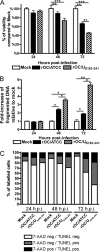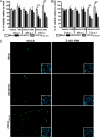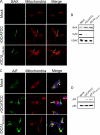Human coronavirus-induced neuronal programmed cell death is cyclophilin d dependent and potentially caspase dispensable
- PMID: 22013052
- PMCID: PMC3255912
- DOI: 10.1128/JVI.06062-11
Human coronavirus-induced neuronal programmed cell death is cyclophilin d dependent and potentially caspase dispensable
Abstract
Human coronaviruses (HCoV) are recognized respiratory pathogens. Some HCoV strains, including HCoV-OC43, can invade the central nervous system, where they infect neurons, with unclear consequences. We have previously reported that HCoV-OC43 infection of human neurons activates the unfolded-protein response and caspase-3 and induces cell death and that the viral spike (S) glycoprotein is involved in the process. We now report on underlying mechanisms associated with the induction of programmed cell death (PCD) after infection by the reference HCoV-OC43 virus (rOC/ATCC) and a more neurovirulent and cytotoxic HCoV-OC43 variant harboring two point mutations in the S glycoprotein (rOC/U(S183-241)). Even though caspase-3 and caspase-9 were both activated after infection, the use of caspase inhibitors neither reduced nor delayed virus-induced PCD, suggesting that these proteases are not essential in the process. On the other hand, the proapoptotic proteins BAX, cytochrome c (CytC), and apoptosis-inducing factor (AIF) were relocalized toward the mitochondria, cytosol, and nucleus, respectively, after infection by both virus variants. Moreover, LA-N-5 neuronal cells treated with cyclosporine (CsA), an inhibitor of the mitochondrial permeabilization transition pore (mPTP), or knocked down for cyclophilin D (CypD) were completely protected from rOC/ATCC-induced neuronal PCD, underlining the involvement of CypD in the process. On the other hand, CsA and CypD knockdown had moderate effects on rOC/U(S183-241)-induced PCD. In conclusion, our results are consistent with mitochondrial AIF and cyclophilin D being central in HCoV-OC43-induced PCD, while caspases appear not to be essential.
Figures







Similar articles
-
Pivotal Role of Receptor-Interacting Protein Kinase 1 and Mixed Lineage Kinase Domain-Like in Neuronal Cell Death Induced by the Human Neuroinvasive Coronavirus OC43.J Virol. 2016 Dec 16;91(1):e01513-16. doi: 10.1128/JVI.01513-16. Print 2017 Jan 1. J Virol. 2016. PMID: 27795420 Free PMC article.
-
Porcine epidemic diarrhea virus induces caspase-independent apoptosis through activation of mitochondrial apoptosis-inducing factor.Virology. 2014 Jul;460-461:180-93. doi: 10.1016/j.virol.2014.04.040. Epub 2014 Jun 5. Virology. 2014. PMID: 25010284 Free PMC article.
-
Novel treatment with neuroprotective and antiviral properties against a neuroinvasive human respiratory virus.J Virol. 2014 Feb;88(3):1548-63. doi: 10.1128/JVI.02972-13. Epub 2013 Nov 13. J Virol. 2014. PMID: 24227863 Free PMC article.
-
AIF-mediated caspase-independent necroptosis: a new chance for targeted therapeutics.IUBMB Life. 2011 Apr;63(4):221-32. doi: 10.1002/iub.432. Epub 2011 Mar 24. IUBMB Life. 2011. PMID: 21438113 Review.
-
Neuroinvasive and neurotropic human respiratory coronaviruses: potential neurovirulent agents in humans.Adv Exp Med Biol. 2014;807:75-96. doi: 10.1007/978-81-322-1777-0_6. Adv Exp Med Biol. 2014. PMID: 24619619 Free PMC article. Review.
Cited by
-
Experimental Models for the Study of Central Nervous System Infection by SARS-CoV-2.Front Immunol. 2020 Aug 28;11:2163. doi: 10.3389/fimmu.2020.02163. eCollection 2020. Front Immunol. 2020. PMID: 32983181 Free PMC article. Review.
-
Natural Antioxidants: A Review of Studies on Human and Animal Coronavirus.Oxid Med Cell Longev. 2020 Aug 12;2020:3173281. doi: 10.1155/2020/3173281. eCollection 2020. Oxid Med Cell Longev. 2020. PMID: 32855764 Free PMC article. Review.
-
Outcomes of RIP Kinase Signaling During Neuroinvasive Viral Infection.Curr Top Microbiol Immunol. 2023;442:155-174. doi: 10.1007/82_2020_204. Curr Top Microbiol Immunol. 2023. PMID: 32253569 Free PMC article. Review.
-
Host Factors in Coronavirus Replication.Curr Top Microbiol Immunol. 2018;419:1-42. doi: 10.1007/82_2017_25. Curr Top Microbiol Immunol. 2018. PMID: 28643204 Free PMC article. Review.
-
Pivotal Role of Receptor-Interacting Protein Kinase 1 and Mixed Lineage Kinase Domain-Like in Neuronal Cell Death Induced by the Human Neuroinvasive Coronavirus OC43.J Virol. 2016 Dec 16;91(1):e01513-16. doi: 10.1128/JVI.01513-16. Print 2017 Jan 1. J Virol. 2016. PMID: 27795420 Free PMC article.
References
-
- Agol VI, et al. 1998. Two types of death of poliovirus-infected cells: caspase involvement in the apoptosis but not cytopathic effect. Virology 252:343–353 - PubMed
Publication types
MeSH terms
Substances
Grants and funding
LinkOut - more resources
Full Text Sources
Research Materials

